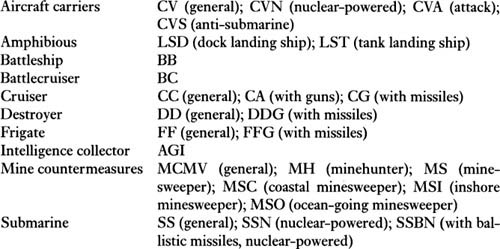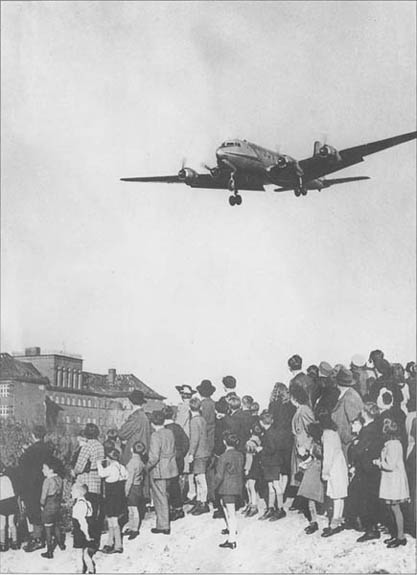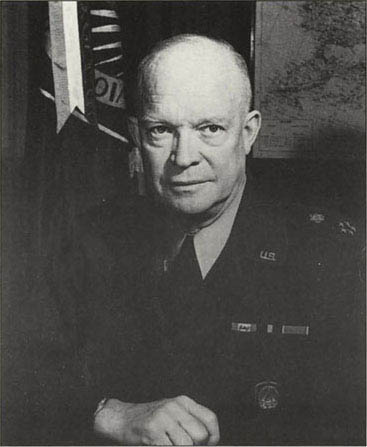The Cold War: A MILITARY History (74 page)

• Mechanized infantry. Troops whose basic means of transport was infantry combat vehicles.
• Motorized infantry. Troops which moved in wheeled vehicles.
• Motor-rifle. English translation of the Russian designation of mechanized infantry; applied to Warsaw Pact forces only.
• Panzer grenadiers. West German designation for troops mounted in infantry combat vehicles and who were capable of fighting from those vehicles.
INR
Initial nuclear radiation.
IRBM
Intermediate-range ballistic missile – a land-based missile with a range between 1,500 nautical miles (2,780 km) and 3,000 nautical miles (5,560 km). In about 1980 this term changed to ‘IBM’.
Knot
A speed of one
nautical mile
per hour.
KT
Kiloton – see
Yield
.
LANDJUT
Land Forces Jutland (NATO).
Launch-on-warning
Strategic retaliation using
ICBM
s on receiving information of incoming hostile
ballistic missiles
. The aim was for the retaliating ICBMs to be clear of their silos before the hostile missiles arrived, thus ensuring their survival and continued flight to their targets.
Launch-under-attack
Strategic retaliation using
ICBM
s in which the missiles would be launched while actually under attack. This implies that the executive decision to launch has not been given in sufficient time to achieve
launch-on-warning
.
Launch weight
The total weight of a fully loaded missile at the time of launch, including
boosters, post-boost vehicle
and
warheads
.
Limited war
A conflict in which the participants exercise some form of geographical or escalatory restraint, either voluntarily or under pressure from outside powers.
LRTNF
Long-range tactical nuclear forces.
Mach number
Speed expressed as multiples of the speed of sound (Mach 1), which at sea level is approximately 1,200 km/h, but varies with temperature and pressure.
MAD
Mutually assured destruction – the ability of the two superpowers to impose unacceptable destruction on their opponent at any time during the course of a nuclear war, even following a surprise attack.
MCMV
Mine-countermeasures vessel.
Mechanized infantry
See
Infantry
.
MICV
See
ICV
.
MIRV
Multiple independently targeted re-entry vehicle – one of several
warheads
mounted on
ICBM
s or
SLBMs
which can be targeted on separate targets up to several hundred kilometres apart.
MNC
Major NATO command/commander.
Motorized infantry
See
Infantry
.
Motor-rifle
See
Infantry
.
MRBM
Medium-range ballistic missile – a land-based missile with a range between 600 nautical miles (1,110 km) and 1,500 nautical miles (2,780 km).
MRV
Multiple re-entry vehicle – one of several separate
warheads
mounted on
ICBM
s or
SLBMs
which can be targeted on the same target or on a number of targets sited very close to each other. In principle, this is similar to firing pellets from a shotgun.
MSBS
Mer–Sol Balistique Stratégique
– the French designation for France’s submarine-launched
ballistic missile
.
MSC
Major subordinate command/commander (NATO).
MT
Megaton – See
Yield
.
NATO
North Atlantic Treaty Organization.
NATO designations
During the Cold War, NATO seldom knew the correct Soviet names for Warsaw Pact equipment. Such equipment was therefore assigned ‘reporting names’ and designations.
Missile designations consisted of a type identifier (usually two letters) and a unique number. The type identifier could be suffixed by ‘N’ for a naval system and by ‘X’ for an experimental system. The type numbers were allocated sequentially, and sub-types were indicated by ‘Modification’ numbers (the original version being ‘Mod 0’). The most common type designators were:
• SS – surface-to-surface (e.g. SS-18, SS-N-20);
• SA – surface-to-air. (e.g. SA-16 Mod 1).
A different system applied to Soviet tanks, which were designated by the letter ‘T’ followed by the year that production began (e.g. T-54, T-55, T-72, etc.).
Soviet submarine classes were given nicknames, which were supposed to be applied in alphabetical order (e.g. Whiskey class, Alfa class, etc.). The exception to this system was when NATO allocated the name ‘Typhoon class’ to a type known to be named ‘
Taifun
’ by the Soviets. The system became confused, however, when NATO ran out of letters and designated a new class the Akula class (
akula
is the Russian word for shark), following which the Soviets named a different class the
Akula
class.
Naval Infantry
Soviet marines.
NBC
Nuclear, biological, chemical (weapons).
nm
Nautical mile. 1 nm = 1.853 km.
NORTHAG
Northern Army Group (NATO).
Nuclear propulsion/power
A system using nuclear energy – usually applied to ships and submarines.
Nuclear war
A war in which nuclear weapons are used.
Panzer grenadiers
See
Infantry
.
PBV
See
Post-boost vehicle
.
Penaid
See
Penetration aid
.
Penetration aid
A device, carried on the
post-boost vehicle
on an
ICBM
or
SLBM
, which is designed to confuse the enemy as to the number and trajectory of the real
warheads
.
Post-boost vehicle (PBV)
A device carried on the
front end
of a missile, upon which are mounted the
re-entry vehicles
(RVs), plus guidance and propulsion packages and
penetration aids
, which dispenses the RVs sequentially towards their targets. Also known as a ‘bus’.
PSC
Principal subordinate command/commander (NATO).
Regiment
See
Army formations and units
.
Re-entry vehicle (RV)
A body carried on the front end of a missile to protect a nuclear warhead when the missile re-enters the earth’s atmosphere.
RV
See
Re-entry vehicle
.
SAC
Strategic Air Command (US).
SACEUR
Supreme Allied Commander Europe (NATO).
SACLANT
Supreme Allied Commander Atlantic (NATO).
SALT
Strategic Arms Limitation Talks (or Treaty). There were two SALT treaties:
• SALT I. Signed in Moscow on 26 May 1972; came into effect on 3 October 1972.
• SALT II. Signed in Vienna on 18 June 1979. Not ratified by the US Senate, but the USA and the USSR tacitly agreed to adhere to its terms.
SAM
Surface-to-air missile.
Second strike
A strategic concept in which the victim of a surprise
first strike
retains sufficient nuclear capability to launch a strike which will attempt to inflict unacceptable damage on the aggressor.
SHAPE
Supreme Headquarters Allied Powers Europe (NATO).
Ship designation
The system of ship designation developed by the US navy in
the
1920s was adopted first by NATO and subsequently by the majority of navies around the world. The main designations relevant to this book are:

SIGINT
Signals intelligence – intelligence derived from monitoring enemy tele-communications systems. See also
ELINT
.
SIOP
Single Integrated Operational Plan – the US master plan for strategic nuclear attack on the Soviet Union. Specific versions were identified by the year, which was added as a suffix – e.g. ‘SIOP-68’.
SLBM
Submarine-launched
ballistic missile
. (Note that, unlike land-based missiles, SLBMs were not subdivided according to range.)
SLCM
Ship/submarine-launched
cruise missile
.
Soft
In strategic terms, describes an unprotected (as opposed to a ‘
hardened
’) target.
SRAM
Short-Range Attack Missile.
SS
Submarine, conventionally (i.e. diesel-electric) powered.
SSBN
Submarine, ballistic, nuclear – i.e. a nuclear-powered
ballistic-missile
submarine.
SSBS
Sol–Sol Balistique Stratégique
– the French designation for France’s land-based
ballistic missiles
. Note that, although designated ‘strategic’ by France, SSBSs were intermediate-range (
IRBM
s) according to the US/Soviet definition agreed in
SALT
.
SSM
Surface-to-surface missile.
SSN
Submarine, nuclear – i.e. a nuclear-powered attack submarine.
Stage
A self-contained rocket motor and fuel tank which is an integral part of the missile structure and which drops away when its fuel has been used up.
Surface zero
The point on the sea’s surface vertically above or below the centre of a nuclear explosion – equivalent to
ground zero
for an explosion on land.
TEL
Transporter–erector–launcher. A wheeled or tracked device which carried a missile, raised it into the firing position, and then launched it.
Throw weight
The useful weight which can be placed on a trajectory towards the target by the main or boost stage of a missile. In
SALT
II, throw weight was defined as the sum of the weights of the
re-entry vehicle(s)
, plus any
post-boost vehicle
, plus
penetration aids
, and their releasing mechanisms.
TREE
Transient radiation effects on electronics.
USAF
United States Air Force.
V/STOL
Vertical/short take-off and landing.
Warhead
The explosive device of a weapon, either nuclear or conventional. In a
ballistic missile
the warhead was carried inside a
re-entry vehicle
.
Yield
The energy released in a nuclear explosion, expressed in terms of the equivalent number of tons of TNT (high explosive) releasing the same energy. It is normally expressed in terms of thousands of tons of TNT (kilotons) or millions of tons (megatons). The energy is principally released as nuclear radiation, thermal radiation and blast energy, the proportions of each depending upon the medium in which the explosion occurs – i.e. whether the explosion is an air, surface or sub-surface burst.

West Berliners watch a US transport aircraft bringing essential supplies to Tempelhof Airfield during the Berlin Airlift. The Soviet blockade of Berlin lasted from 22 June 1948 to 12 May 1949, and the Western Allies’ united and steadfast response to it was a prelude to the Cold War

General of the Army Dwight D. Eisenhower was recalled from retirement when he was appointed NATO’s first Supreme Allied Commander Europe (SACEUR) on 19 December 1950. He served the Alliance until 1952, when he returned to the United States to run for president
